

Royal Botanic Garden Edinburgh. Flowering Plants of Australia (part 1) : Royal Botanic Garden Edinburgh. Be a part of Citizen Science and Help MPM Digitize Our Collections! ICEDIG – glimpse on the diversity of European collections : ICEDIG. Opening-up Crépin’s Rose Herbarium by New Technologies: a Pilot Project. OpenLitterMap. iNaturalist 2018 Species Classification Competition. By Oisin Mac Aodha, Grant Van Horn, and David Rolnick Computer vision will play a crucial role in visual search, self-driving cars, medicine and many other applications.
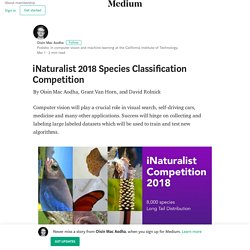
Success will hinge on collecting and labeling large labeled datasets which will be used to train and test new algorithms. One area that has seen great advances over the last five years is image classification i.e. determining automatically what objects are present in an image. DIGIVOL. L'herbier virtuel du Prince Bonaparte. L'herbier de l'Université Lyon 1 L’Herbier de l’Université Lyon1 est l’un des plus grands herbiers au monde.

Il abrite environ 4,4 millions de plantes séchées d’une grande richesse scientifique et patrimoniale. Become a Citizen Scientist! The National Biodiversity Data Centre, which is also known as Ireland’s Citizen Science Portal, is asking us to record certain spring flowers that we see.
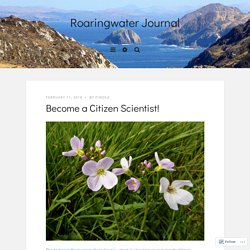
This is not a task, it’s a pleasure! What could be more delightful than wandering down a country boreen, stopping to admire the flowers (like the Cuckooflowers above, seen near Bantry) and in about a minute, sending off a record to the Data Centre? Common Dog-violets, Greenmount, near Ballydehob Yes, they have made it that easy, with the most amazing little app. Amateur mycologists can assist to conserve fungi. The Facebook of plant science. By building PhotosynQ – a handheld device with sensors and an online data-sharing and analysis platform – a team of Michigan State University researchers is creating the plant-science equivalent of Facebook.
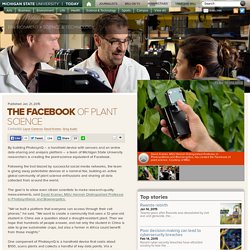
Following the trail blazed by successful social media networks, the team is giving away patentable devices at a nominal fee, building an active global community of plant science enthusiasts and sharing all data collected from around the world. The goal is to allow even citizen scientists to make research-quality measurements, said David Kramer, MSU Hannah Distinguished Professor in Photosynthesis and Bioenergetics.
Home. Les agrocarburants. Niveau : Moyen - Les herbonautes. Les agrocarburants (appelés aussi "biocarburants") désignent un type de carburants produit à partir de matière organique végétale non fossile (biomasse).

La première génération d’ agrocarburants a émergé après la crise du pétrole dans les années 70, en vue de remplacer les combustibles fossiles par de nouvelles sources d’énergie. L'utilisation de ces ressources naturelles écologiques est depuis controversée et accusée de mettre à mal la sécurité alimentaire des pays du Sud et l'environnement, tout en contribuant à l'accaparement des terres.
Depuis la première génération d'agrocarburants des efforts ont été réalisés pour développer de nouvelles générations d'agrocarburants dans le but de contrecarrer les effets négatifs de la première génération. Parmi les nombreuses cultures pour la fabrication des agrocarburants figurent le soja, le maïs, le colza, l’arachide, le tournesol, le palmier à huile, la canne à sucre, le peuplier et l’eucalyptus. Les agrocarburants de première génération. Die Herbonauten.
Treeversity — Zooniverse. Treeversity: Online Citizen Science Initiative. An online citizen science initiative Interested in learning about plant science and exploring a visual catalog of the Arboretum’s Living Collections?
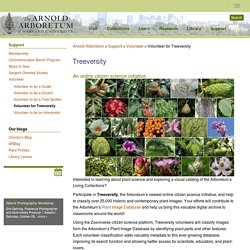
Participate in Treeversity, the Arboretum’s newest online citizen science initiative, and help to classify over 25,000 historic and contemporary plant images. Your efforts will contribute to the Arboretum’s Plant Image Database and help us bring this valuable digital archive to classrooms around the world! Using the Zooniverse citizen science platform, Treeversity volunteers will classify images from the Arboretum’s Plant Image Database by identifying plant parts and other features. Each volunteer classification adds valuable metadata to this ever-growing database, improving its search function and allowing better access for scientists, educators, and plant-lovers. Participate in Worldwide Citizen Science. Les herbonautes: Proteaceae d'Afrique. Si les Proteas sont surtout connus comme genre emblématique de la région du Cap, les plantes de la famille des Proteaceae (environ 80 genres et plus de 1500 espèces) sont largement répandues dans l'hémisphère australe.
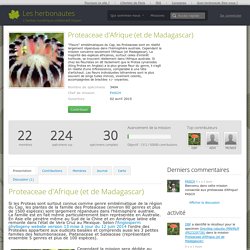
La famille est en fait même particulièrement bien représentée en Australie. En Asie elle pénètre même au Sud de la Chine et en Amérique latine elle remonte dans l'état de Vera Cruz au Mexique. Selon l'Angiosperm phyllogeny website version 13 mise à jour du 12 juin 2014 l'ordre des Proteales appartient aux eudicots basales et comprends aussi les 3 petites familles des Nelumbonaceae, Platanaceae et Sabiaceae (représentant ensemble 5 genres et plus de 100 espèces). Community.canadensys. Monday, 5 February 2018 Note: the mission is only in French but it is quite straightforward to navigate in the platform You have some free time ahead and you would like to help with the digitization of the Marie-Victorin herbarium (Herbarium of the University of Montréal) ?
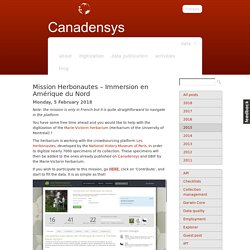
The herbarium is working with the crowdsourcing platform Les Herbonautes, developed by the National History Museum of Paris, in order to digitize nearly 7000 specimens of its collection. Crowdsourcing and Libraries. In 2005, a team of marine biologists led by Glenn Jones of Texas A&M University used inflation-adjusted pricing data from the New York Public Library’s (NYPL) collection of 45,000 restaurant menus, among other sources, to confirm the commercial overharvesting of abalone stocks along the California coast beginning in the 1920s, a sharp decline in the East Coast’s inshore lobster population that began in the 1950s, and other information regarding historical stocks of swordfish, oysters, halibut, haddock, sole, and other popular seafood.

This goes to show how special collections can prove useful to researchers in varied and unexpected ways. Here, a novelist peruses NYPL’s unique menu collection to cook delectable dinner details into a historical mystery. There, a paleo oceanographer expands his field’s understanding of how seafood consumption trends of the 19th and 20th centuries impacted the sustainability of modern fisheries. The business end. Worldwide Engagement for Digitizing Biocollections (WeDigBio): The Biocollections Community's Citizen-Science Space on the Calendar. Skip to Main Content Sign In Register Close Advanced Search.
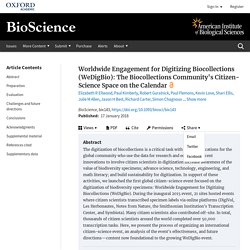
Wedigbio. Worldwide Engagement for Digitizing Biocollections (WeDigBio): The Biocollections Community's Citizen-Science Space on the Calendar. Skip to Main Content Sign In Register Close Advanced Search Online ISSN 1525-3244 Print ISSN 0006-3568 Copyright © 2018 American Institute of Biological Sciences Connect Resources Explore Oxford University Press is a department of the University of Oxford. Close. Orchid Observers. Late spring and early summer is the best time to see the UK’s much-loved wild orchids, with many species in full bloom, showing off their ornate and colourful flowers.
Now experts behind citizen science project Orchid Observers want people’s photographs of these exquisite plants, to help them find out how climate change might be affecting orchids and other UK wildlife. The project, launched last month at the start of the orchid flowering season, is organised by the Natural History Museum in London and the University of Oxford’s Zooniverse (a website which hosts major public science projects). Head of the Natural History Museum Centre for Biodiversity Dr John Tweddle said the survey has had a “brilliant response” so far, with up to 250 images submitted.
In about another week or so, we’re really going to hit main orchid season. And then it’s going to be common spotted, marsh orchids, helleborines, the whole shebang. Orchid observers. Meet the Museum's core citizen science team. Nature's Notebook Curriculum & Activities: National Phenology Network. This worksheet has been used in teacher training workshops and in docent training courses. The purpose is to provide some guidelines for planning a phenology monitoring program at your site. It includes guiding information on how to develop a science question and space to plan short-medium-long term goals for a phenology monitoring program.
It also offer space to brainstorm some activities that may be plugged in to achieve these programmatic outcomes. Robotics. The Departments of Plant Science and Engineering at the University of Oxford in collaboration with BSBI, Natural England and Field Studies Council wish to explore the efficiency of digital recognition software for identifying UK flowering plants through photographs of their flowers (Flower-Power). The final outcome of the project being, at the very least, a mobile phone app to identify UK flowering plants. The first part of the project involves gathering and assembling a minimum of 40 photographs per species to allow the relevant software to build up a ‘picture’ of the variation of photographs taken at different light intensities and angles. We plan to begin assembling the photographs in April 2015 with a view to implementing, if possible, the digital recognition part of the project by the beginning of 2016. Science Gossip. About ‘Science Gossip’ The publication of books and periodicals are key locations for visualizing knowledge about the natural world.
The Biodiversity Heritage Library has digitized and catalogued millions of pages of printed text between the 1400's and today related to the investigation of the natural world. Contribute to Kew’s scientific work – we need your help! New Tree App Builds Partnerships Between Citizens and Scientists. Is Climate Change Causing the Seasons to Change? Citizen Science Helps Find Out : Citizen Science Salon. A Seven spot ladybird (Image Credit: Richard Bekker) Interested in more spring themed citizen science projects? Great New Citizen Science project to record our fossils. Posted on August 17, 2015 by David Gelsthorpe We have a fantastic new Citizen Science project to record our fossils called Reading Nature’s Library! Botanical Society of Scotland. Documenting the Flora of the Nation’s First Urban Park System. Orchid observers. Volunteer Portal - Treasures of the New York Botanical Garden Herbarium. Participate in Worldwide Citizen Science. Transcribing Seed & Nursery Catalogs.
What's Up with Seed Catalogs in BHL? We've spent a fun-filled week exploring the history, art, and science of gardening with our Garden Stories event. Help us Improve Access to Seed and Nursery Catalogs! Crowdsourcing and BHL: Current Projects. Recent crowdsourcing initiatives are revolutionizing scientific research, allowing the public to help scientists and researchers document, identify, and better understand biodiversity.
For example, the Atlas of Living Australia’s FieldData program allows anyone to contribute sightings, photos and observational data to help researchers and natural resource management groups collect and manage biodiversity data. Tag over a Million Biodiversity Images in Flickr for BHL. Two Ways to Access BHL Images in Flickr. Smorball and Beanstalk Are Live! Carex on Herbaria@Home » Botanics Stories. McGill herbarium needs you! MapInvasives. The last set of herbarium images… La gomme arabique - Les herbonautes. Les travaux botaniques de la Commission Scientifique du Mexique (1863 - 1867) - Les herbonautes. The fever tree labels: Kew.